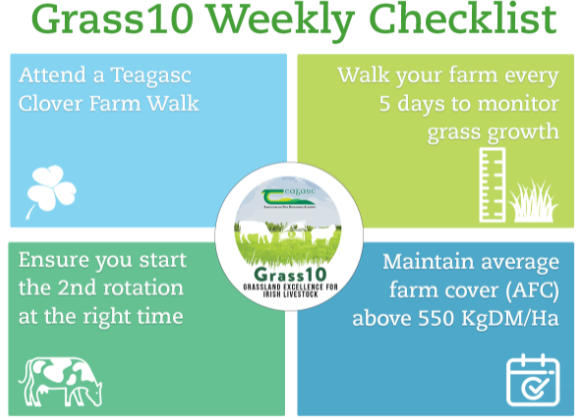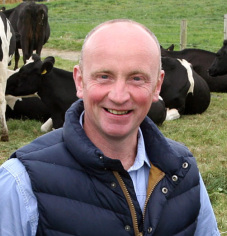06 April 2022
Grass10 Newsletter – 5th April 2022

This week’s Grass10 newsletter has the Teagasc Clover Farm Walks upfront. Book your spot here. Get predicted growth & soil temperatures, the Grass10 weekly checklist, walk your farm every 5 days – one of the Grass10 weekly tips, featured farmer Oisin Gill, The Clover Reporter with Jim White and more
190th Edition – 5th April 2022

Book Your Spot on a Clover Farm Walk



Grass10 Weekly Tips
Attend a Teagasc Clover Farm Walk
The benefits grass-clover swards provide ought to be a real consideration for your farm for improved animal performance and reduction in chemical nitrogen whilst maintaining pasture growth. This is good for your pocket and the natural environment. Maek attending a Teagasc Clover Farm Walk a priority for you in the coming week or two (see list of events above)
Walking your farm every 5 days
Ensuring there is a good supply of high quality grass is, and should be, the priority coming into April when many farms are starting the 2nd grazing rotation. This is more crucial than ever with input prices. Cow milk yield peaks, breeding season for suckler and diary cows begins, and demand for grass on sheep farms is high at a time of year when grass growth transitions from low to high growth rates. A sufficient supply of green leafy grass is paramount. Walking the farm every 5 days allows you to make decisions to keep on track with AFC (600 KgDM/ha), Cover/cow (180-200 kgDM/cow), Days Ahead (12-14 days), and match demand to grass growth.
Using the Grass10 “3 checks” for a timely start to your 2nd rotation
Whilst some farms have already moved onto the 2nd rotation, many must manage the remaining grass on your 1st rotation to ensure adequate grass covers at the start of the 2nd rotation by completing the Grass10 “3 checks!”. The first check is to keep AFC 550-600 KgDM/ha for the start of the 2nd roation. The 2nd check is to identify grass covers back on your 1st 4 paddocks grazed. The first 4 paddocks should have covers 1000-1200 KgDM/ha, calculate how manys away you are from this. On some farms it may be necessary to graze a paddock at 1200 KgDM/ha on the 2nd rotation before finishing the 1st rotation. The 3rd check is to make a plan for how many days you have left on your 1st rotation. Coupled with your review of what you have on the 1st paddocks, you will then be able to make an informed decision on whether to push out the start of the 2nd rotation and introduce supplement.
Maintain the average farm cover (AFC)
Walking your farm will identify AFC. This is a crucial figure when it comes to predicting growth on your farm. Letting AFC drop below 550 KgDM/ha will have a devastating affect on grass growth rates. Pregrazing yield should be 1100-1200 KgDM/ha. ‘Grass grows grass’ is true. So ‘less grass grows less grass’ must also be true. If your demand/ha is greater than growth/ha then your AFC will drop. Make decisions to reduce demand to hold AFC until growth rates increase, e.g. growth at 30 KgDM/ha and stocked at 3.0 LU/ha should match demand to 30 KgDM/ha to hold AFC. 30 / 3 = 10 KgDM grass per cow. Assuming feeding 4 kg meal, then about 4 KgDM silage needed to buffer and hold AFC.
Grass10 Featured Farmer
Oisin Gill, Hollymount, Co. Mayo
 Oisin Gill farms in Hollymount, Co. Mayo, milking 200 cows, stocked at 3 cows/Ha on the milking platform.
Oisin Gill farms in Hollymount, Co. Mayo, milking 200 cows, stocked at 3 cows/Ha on the milking platform.
Oisin is hosting one of our Clover Farm Walks on the 13th April at 11am ( see image above for eircode and further details of clover walks near you!)
“I have 95% grazed to date and I have 2 paddocks remaining on the 1st rotation. I will be a tight for 10 days so I have reintroduced silage back into the diet and meal is increased to 6kg. I have 900-1000 kg DM/Ha on my 1st 3 or 4 paddocks and I would like them to have 1100 Kg DM/Ha +”
Clover Farm Walk Series

Jim White farms outside Mullinahone, Co. Tipperary. In this video Jim highlights why he is using clover on his farm to reduce his chemical nitrogen usage. Jim is adamant that the clover walks are important for farmers to help them manage it, “the machine might set clover but it won’t manage it”
Click here to view video with farmer Jim White



This section will give weekly reports and videos from farmers who have a lot of clover established on their farms
Dairy farmer Jim White from Tipperary tells us his plan and top tips for oversowing clover. Jim is hosting a clover walk on his farm this Thursday, April 7th (see advert).
“The paddocks I am oversowing with clover this year are all beside each other in one block. This makes it easier for grazing and fertiliser management throughout the year”
Click here to read the Clover Reporter
Sign up for weekly grass 10 newsletter

